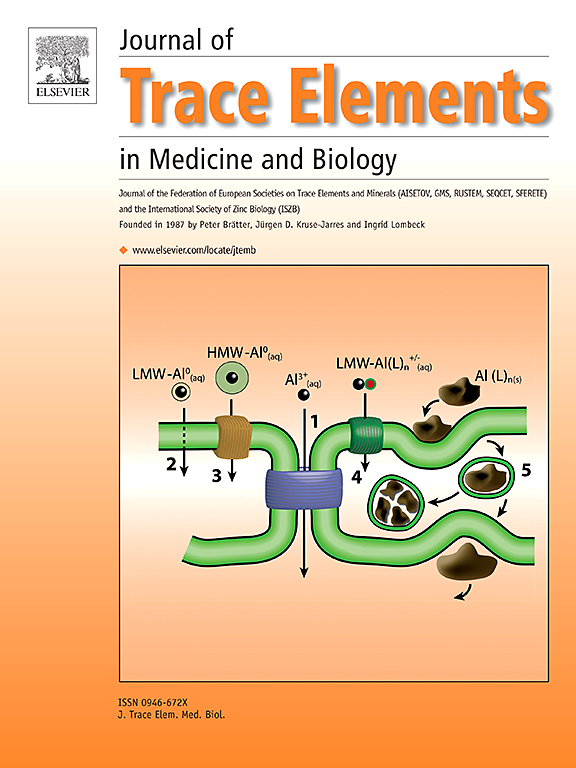How does zinc chelation affect liver sphingolipid metabolism in an Alzheimer's-like model?
IF 3.6
3区 医学
Q2 BIOCHEMISTRY & MOLECULAR BIOLOGY
Journal of Trace Elements in Medicine and Biology
Pub Date : 2025-02-01
DOI:10.1016/j.jtemb.2025.127589
引用次数: 0
Abstract
Background
The present study aimed to evaluate the impact of Cyclo-Z, a combination of Cyclo (His-Pro) plus zinc, on hepatic sphingolipid (SL) metabolism and antioxidant properties in a rat model of Alzheimer's disease (AD).
Methods
Alzheimer's disease rat model created via intracerebroventricular (i.c.v.) amyloid beta-42 oligomer (AβO) injection into the lateral ventricles. Cyclo-Z administration was performed with daily gavage for 3 weeks after the AβO injection. Ceramide, ceramide kinase (CERK), sphingosine 1 phosphate (S1P), glutathione (GSH), total oxidant capacity (TOS), 4-hydroxynonenal (HNE) and caspase-3 levels were measured with Elisa kit in liver tissue.
Results
S1P, CERK and GSH levels increased and ceramide, TOS, 4 HNE, and caspase-3 levels decreased in the liver tissues of AD group. Cyclo-Z treatment decreased S1P, CERK, ceramide and caspase-3 levels but increased TOS and 4-HNE levels in the liver tissues of AD group.
Conclusion
These results showed that SL metabolism was modulated to generate an anti-apoptotic defense system in liver tissue of AD rats
锌螯合如何影响阿尔茨海默病样模型的肝鞘脂代谢?
背景:本研究旨在评估cycloo (His-Pro)加锌组合cycloo - z对阿尔茨海默病(AD)大鼠肝鞘脂(SL)代谢和抗氧化特性的影响。方法:侧脑室注射淀粉样蛋白β -42寡聚物(AβO)建立阿尔茨海默病大鼠模型。注射AβO后,每天灌胃给环z,持续3周。采用Elisa试剂盒检测肝组织中神经酰胺、神经酰胺激酶(CERK)、鞘氨醇1磷酸(S1P)、谷胱甘肽(GSH)、总氧化能力(TOS)、4-羟基壬烯醛(HNE)、caspase-3水平。结果:AD组肝组织中S1P、CERK、GSH水平升高,神经酰胺、TOS、4hne、caspase-3水平降低。环z治疗降低了AD组肝组织中S1P、CERK、神经酰胺和caspase-3水平,升高了TOS和4-HNE水平。结论:通过调节SL代谢在AD大鼠肝组织中产生抗凋亡防御系统。
本文章由计算机程序翻译,如有差异,请以英文原文为准。
求助全文
约1分钟内获得全文
求助全文
来源期刊
CiteScore
6.60
自引率
2.90%
发文量
202
审稿时长
85 days
期刊介绍:
The journal provides the reader with a thorough description of theoretical and applied aspects of trace elements in medicine and biology and is devoted to the advancement of scientific knowledge about trace elements and trace element species. Trace elements play essential roles in the maintenance of physiological processes. During the last decades there has been a great deal of scientific investigation about the function and binding of trace elements. The Journal of Trace Elements in Medicine and Biology focuses on the description and dissemination of scientific results concerning the role of trace elements with respect to their mode of action in health and disease and nutritional importance. Progress in the knowledge of the biological role of trace elements depends, however, on advances in trace elements chemistry. Thus the Journal of Trace Elements in Medicine and Biology will include only those papers that base their results on proven analytical methods.
Also, we only publish those articles in which the quality assurance regarding the execution of experiments and achievement of results is guaranteed.

 求助内容:
求助内容: 应助结果提醒方式:
应助结果提醒方式:


